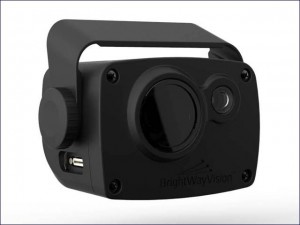Israeli startup BrightWay Vision intends to eliminate the dangerous problems associated with driving at night or in weather conditions causing poor visibility. The innovative BrightEye technology developed by this company – which was born out of internationally renowned defense electronics firm Elbit Systems — is based on existing platforms and technologies, but brings them to a whole new level. BrightEye is a new contrast-imaging technology that monitors the environment facing the vehicle, allowing the driver — with assistance from the active safety systems of the vehicle — an opportunity to avoid hitting other cars, pedestrians, bicyclists and road hazards.
Composed of a camera unit and a light-source unit, BrightEye functions as a stand-alone night-time driving solution or as an integrated solution with existing Advanced Driver Assistance Systems (ADAS) day-time technology, for a 24/7 safety assist system. Another Israeli company, Mobileye, already is a global player in the ADAS space, with its collision-avoidance technology that can “interpret” a scene in real-time and provide drivers with an immediate evaluation based on its analysis. BrightEye adds low-light and bad-weather vision capabilities to the ADAS mix.
CEO and co-founder Ofer David established BrightWay Vision in 2011, as head of electro-optics at the Israel-based Elbit. His idea was to expand into the civilian market with aspects of Elbit’s groundbreaking advances in night vision for the military. Together with other Elbit staffers such as Yoav Grauer, who now heads BrightWay Vision’s business development and technology, and Eyal Levi, the startup’s engineering manager, David persuaded the powers-that-be to okay the spinoff company and also invest in the venture.
To better explain and pitch their idea, they created a prototype built from components that David, Grauer and Levi had developed during their work at Elbit. But instead of the infrared detector in that original system, the new product has a gated sensor chip. David says this chip is “like the one you have in your cell phone,” and can be incorporated into the device effectively and cheaply. “Our technology cannot work for the army, because the system on the front of the car exhibits a reddish light,” points out David. “It’s something the enemy would be able to see, if it were on a tank.” Corporate liked what it saw, and gave the project a green light once David and his team successfully interested investors from the automotive industry. In 2013, BrightWay Vision was awarded an honorable mention in Tech Briefs magazine’s “2013 Create the Future Design: Transportation & Automotive Category: Making Night Time Driving Safe and Automated.” Today, the Haifa-based company is at an advanced stage of hardware development.
On the road by 2018?
BrightWay Vision’s innovation lies in what is called “active-gated imaging technology.” This is different from the more commonly used thermal imaging, which relies on temperature differences to form a picture. It combines a camera that opens and closes at high speeds, and a pulsed-light illuminator beam. The camera and illuminator are synchronized, so that the images (pedestrians, trees, animals, lane markings, traffic signs, etc.) are projected onto the dashboard screen in their proper depths of field and real-time computer-vision alert functions.
The screen provides the driver with a clear, panoramic view of the road. It’s similar to the effect of turning on one’s bright beams, but without blinding oncoming drivers. The headlights of the cars coming in the opposite direction appear as small dots, with no blinding glare. And the entire area around the road can be visualized with no effort, even if there are no street lamps or ambient lighting David and his team are aiming at two markets: original equipment manufacturers (OEMs) such as GM, Ford and Chrysler; and after-market dealerships, which would add the system to cars already purchased. Several OEMs, in fact, have bought the BrightEye prototype. Within about four years, he predicts, we can expect to see the Israeli invention built in to various car models. In a shorter time, we will have the option of asking dealers to install it on the cars we already own.



















